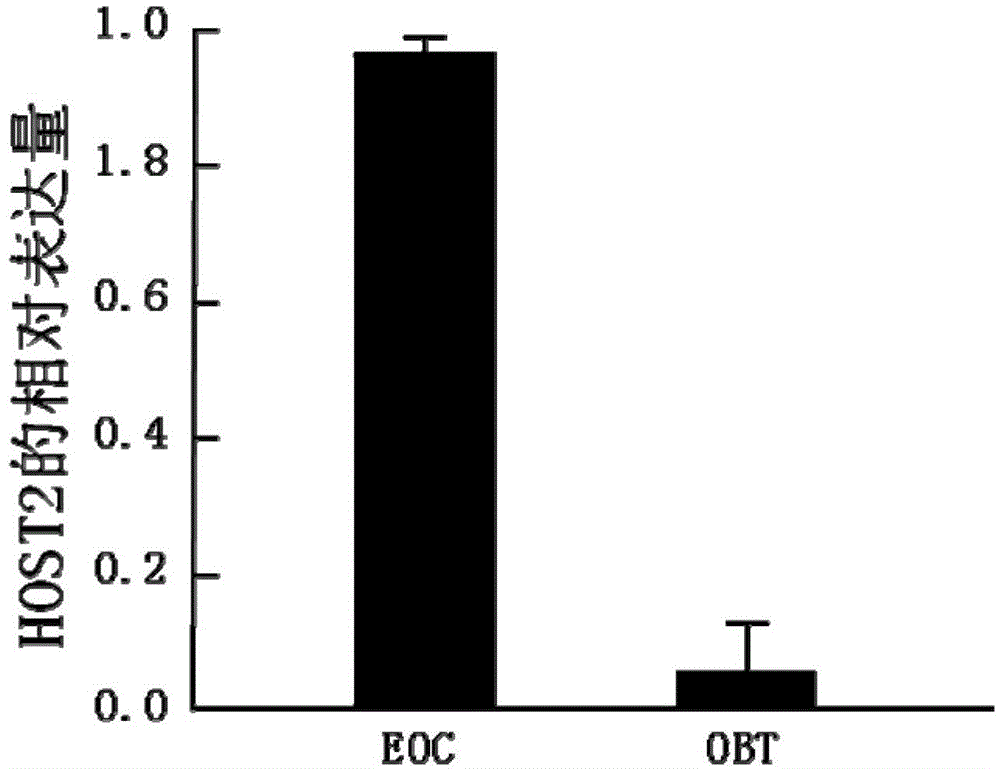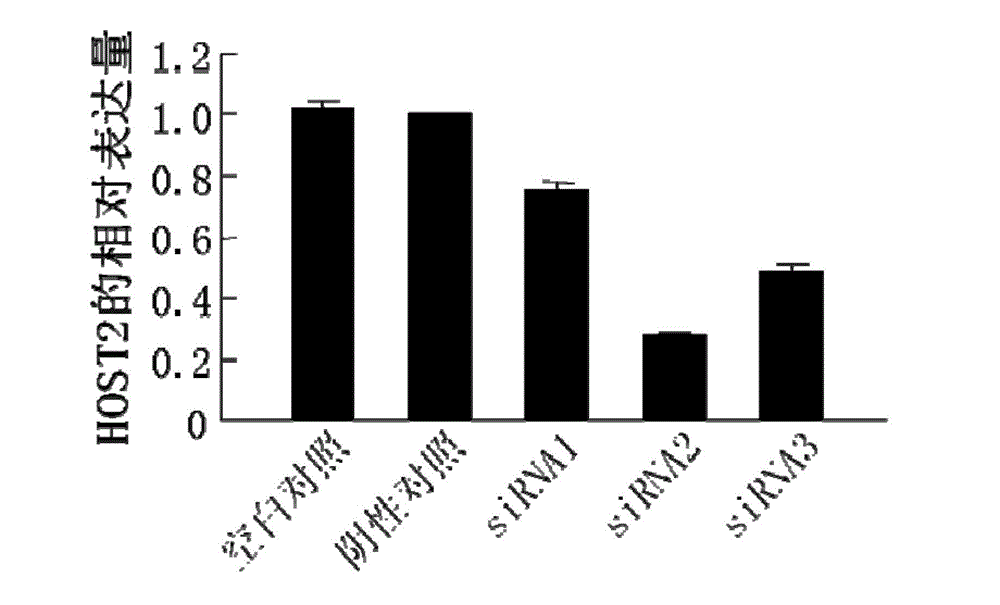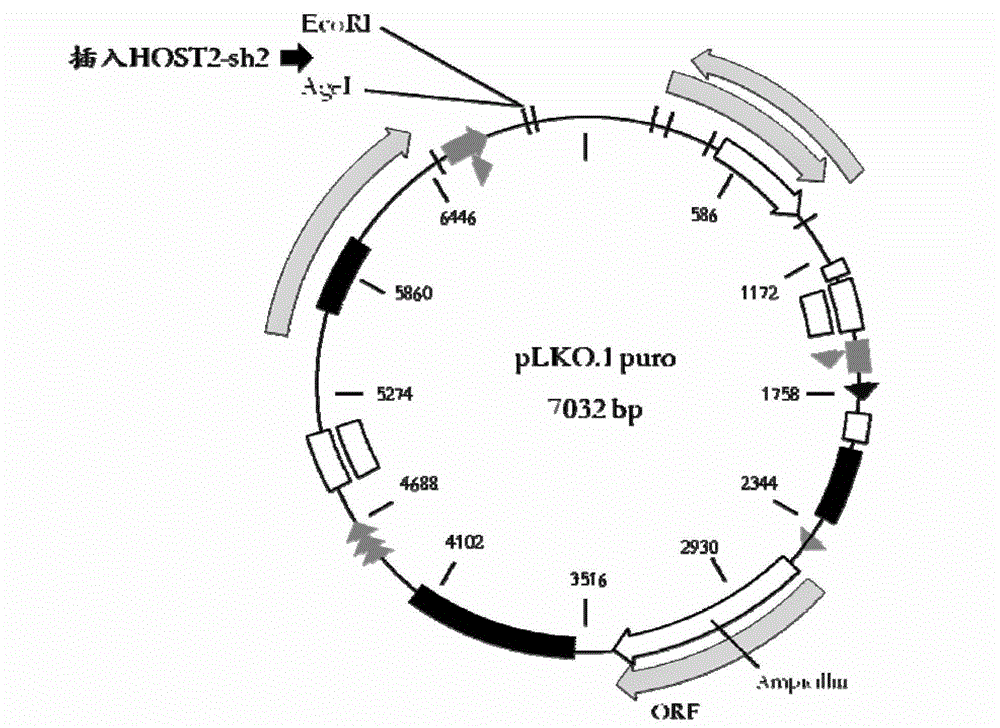siRNA for inhibiting growth of epithelial ovarian cancer as well as recombinant vector and application thereof
A recombinant vector, ovarian cancer technology, applied in the field of genetic engineering, can solve the problems of high difficulty of operation, unimproved treatment effect, no in-depth research report on HOST2, etc., and achieve the effect of inhibiting tumor growth.
- Summary
- Abstract
- Description
- Claims
- Application Information
AI Technical Summary
Problems solved by technology
Method used
Image
Examples
Embodiment 1
[0040] Example 1: Construction of pLKO.1-HOST2-sh2 eukaryotic expression vector
[0041] 1.1 Required reagents
[0042] Restriction enzymes Age I and EcoR I and corresponding Buffer, T4 ligase and its buffer, PCR product purification kit, and gel recovery kit were all purchased from TaKaRa Company (Dalian Bao Biological Engineering Co., Ltd.). The conventional RNAi vector pLKO.1puro (Plasmid8453) was selected as the eukaryotic expression vector, which originated from Addgene, a non-profit organization for plasmid sharing among scientists around the world.
[0043] 1.2 Design, synthesis and screening of HOST2 specific siRNA.
[0044] The HOST2 cDNA sequence is shown in SEQ ID NO:1.
[0045] Design and synthesize specific siRNA1-3 according to the above sequence (all completed by Shanghai Invitrogen):
[0046]
[0047] From figure 2 It can be seen that siRNA2 can inhibit the expression of HOST2 by more than 70%; siRNA1 can only inhibit the expression of HOST2 by about 20...
Embodiment 2
[0054] Embodiment 2: in vitro cell test
[0055] The changes of the biological function of EOC cells before and after HOST2 expression was inhibited were studied by cell scratch test, Transwell test and CCK-8 assay.
[0056] The specific method is as follows:
[0057] 1. Cell scratch experiment
[0058] The cell migration ability was detected by scratch method, and the average migration distance was determined by Image J software. Experimental supplies: 6-well plate, ruler, serum-free medium, PBS / saline, yellow tip, Mark pen, etc.
[0059] Steps: ① Use a Mark pen to draw horizontal lines evenly on the back of the 6-well plate, about every 0.5-1cm, across the holes, and at least 5 lines through each hole. ②Add about 2.5-5×10 to the hole 5 cells, until they grew to about 50%, leaving three blank wells as a control, and transfecting pLKO.1-HOST2-sh2 into the remaining three experimental wells. ③When the cells grow to complete confluence (about 24 hours), use the tip of the y...
Embodiment 3
[0069] Embodiment 3: Simulated treatment experiment in vivo
[0070] 50 BALB / C-nu female nude mice, 4-6 weeks old, weighing about 20g±2g, were randomly divided into two groups (25 mice / group, experimental group and blank control group). Prepare OVCAR-3 single cell suspension, adjust the cell concentration to 1-5×10 7 / mL, take nude mice and inject 100-200 μl of cells subcutaneously on the back near the hind limbs.
[0071]The pLKO.1-HOST2-sh2 plasmid was extracted with a large amount of plasmid extraction kit (Shanghai Tiangen Biological Co., Ltd.), and the density of the plasmid was determined to be 1437 ng / ml by a spectrophotometer. When the tumor grows to an average diameter of 5 mm, inject about 100 ngpLKO.1-HOST2-sh2 recombinant plasmid into the xenograft tumors of nude mice in the experimental group (the injection volume is about 70 μl according to the density calculation), and spray once every 2 days for a total of 30 days , a total of 15 times. After the injection o...
PUM
 Login to View More
Login to View More Abstract
Description
Claims
Application Information
 Login to View More
Login to View More - R&D
- Intellectual Property
- Life Sciences
- Materials
- Tech Scout
- Unparalleled Data Quality
- Higher Quality Content
- 60% Fewer Hallucinations
Browse by: Latest US Patents, China's latest patents, Technical Efficacy Thesaurus, Application Domain, Technology Topic, Popular Technical Reports.
© 2025 PatSnap. All rights reserved.Legal|Privacy policy|Modern Slavery Act Transparency Statement|Sitemap|About US| Contact US: help@patsnap.com



